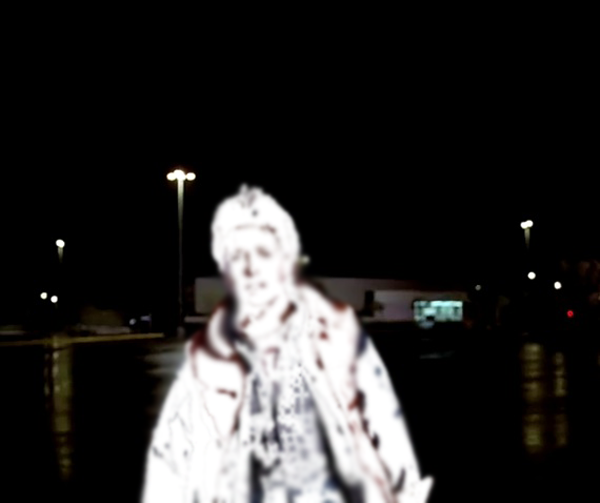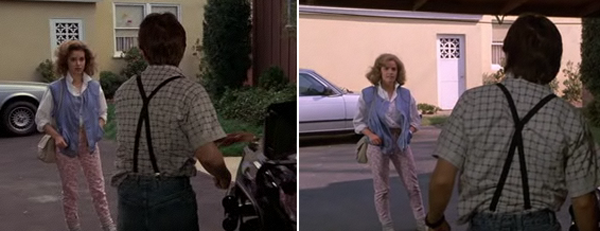Film
Back to a future

Scat-stacking shitty yesterdays together I go back in time, on my therapist’s chair, retrace particular events in my childhood, and open my eyes to the blurry wet room, depleted and calm. He’s been leaning in, elbow dents on his knees, eyes maybe a little wet too. I am trying to correct the past with my personal fucks capacitor. Lived a dumb tv movie life, or better yet when movies from the past wound up on tv; went to college at an English lit class lived a dumb book life, or better yet when those books wound up as movies; moved to a city for a dumb metrosexual life, or better yet someone tell me what that even means. Maybe, the past unforgiving, you moved from one city to another, kept exchanging cities, trading in your tokens at casino life for better cards, fairer dice, the unsightly decorative carpet under your feet, heads locked in vices in rooms you couldn’t see. And if gambling is our metaphor, I’ll be the old guy at the slot machine, the repetitive injury of his right arm pumping away at some statistical god, awaiting the golden shower of coins which will sound as a tambourine, hey play a song for me, I’m not sleepy and there is no place I’m going to. In 1985, with that preceding Orwellian-slash-Van Halenian year neatly tucked behind us, one Marty McFly disappears from a suburban parking lot at night.
Family members fade in an out of photos, a negotiation of determinism, until their revised fates are cast in resin under a glossy finish. This was before the .jpeg, where one held photos in their palm as a dedicated layer of skin. There’s a psychological theory that our developmental minds are records, going in circles under a transcribing needle, and that every trauma — emotional, sexual, physical — we experience is a scratch in the record, forever changing the song, perhaps a rrp where a french horn would be. The younger we are, the deeper the scratch, the more foreign we become, never knowable to others. Our entire adult lives, via mainly the relationships we choose, are subconscious attempts to recreate scenarios in which we can finally master what happened to us. These compulsions are the masochistic auto-vivisection of ourselves.

Marty returns from the past twice, in 1985 and 1989, to two women playing one, Claudia Wells, Elisabeth Shue and Jennifer Parker, respectively — though that barely matters, the charade of girlfriends who may as well be mimes because dudes rarely ever listen. She fell asleep on the porch waiting for him; fortunately, he had a fairly good excuse. It’s impressive how director (Zemeckis, et al) kept the costume designs in some storage bin over the years. Save the presumptive hubris of a sequel, it’s sweet how they brought such awful clothing back to life. Marty opens the garage door to discover his world is the same, a black jeep waiting for the weekend. When I go to my parents house, I open the garage door to a similar scene, but the girl isn’t there, just a perfectly formed floater across my cornea slowly headed towards the upper-left corner of my mind, her translucent image branded on my optic nerve, seared by the glow of my monitor.
Suburbia, with forgiving hindsight, has been promoted to a metaphor. But its adolescent residents, to which I and mostly likely you belonged, know nothing of such aesthetic nostalgia: the pale flat horizons jumbled by near-identical houses, perfectly paved streets whose still gooey asphalt seems to forever stay that way in the sun. The parking lot is indeed a portal of travel — the into mall inside which we establish our future debt with the swipe of a card smaller than our palms, the fine print of an interest rate like chicken scratches. Both Marty and Bart Simpson recklessly skateboard in their intros to establish the implicit safety of the suburbs, where insurance men are all uncles, and cars made of cake. The bovine-like slowness seems sad, though after years of the gritty city, a Chick-fil-A binge before an $80M blockbuster followed by the lobotomy of cable tv seems rather comfy, in grey sweat pants of course, that two-legged flag of surrender, its sheep-like inside lining baaa. I lived on a cul-de-sac, which is just a disguised dead end, its bulbous pit like the hair follicles planted in my scalp which I was to spend the next decade slowly plucking, not knowing what trichotillomania or OCD was, the way for my wavering hand, as an extension of my heart, to go, and stay for awhile. Addiction is a friend, a conversation you get to carry with you anywhere. I became quite good at covering up my bald spots, under a beanie or between the front and back cover of some Russian novel. I was slowly disappearing in a photo never taken.

There are two versions of the past: one what you saw happening as it happened, and two the way you see it now. “Getting some perspective” is a euphemism for accepting how shitty it all was, and how that ossified shit is, however deeply buried, subject to the archaeology of therapy. To excise the wound. Back to the Future II features two Marty McFlys overlapped in simultaneous time during a fateful school dance, along with George McFly, Biff Tannen, and Lorraine maiden name Baines. The camera sets on George’s thin fist for longer than usual, perhaps a call to all nerds to adjust their glasses for the collective fantasy of what they never did, never could do. Biff is knocked out, each sperm cell in his body calling it a night. We first see George from Lorraine’s perspective, then, in the sequel, from Marty’s (this subjective third-person as “friend” protective POV rings of Nick Carraway in The Great Gatsby) as he asks for Lorraine’s hand. If only I could have seen myself from behind me those days in junior high at recess and lunch, chilling at the “boonies,” the perimeter portable classrooms designated for the marginalized set of both the mentally and disciplinarily challenged. I remember one couple, all leather jacket and black eyeliner’d up, hanging out there too in the distance. I would sneak peaks at them kissing, two human-shaped protrusions of the earth tentatively met as one shape wrapped in the gauze of nearness. I would imagine how her lips might feel, or the acrid smell of hairspray which set her bangs as a tiny tsunami on her forehead. Her name was Michelle and she got hell for the rhythm not rhyme of a rumored blowjob that brought her cheap eyeliner to tiny black rivers down her face, clinging at the estuary of her chin. Sad how a girl’s fate can be sealed by the seal of her lips, if it were even true. Facebook is not facebook, but a cemetery of such girls who have different last names now.
George McFly, per either his nervousness and/or dyslexia, says to Lorraine “I’m your density. I mean… your destiny,” which shall be my delicate segue into the quantum mechanical theory that all matter, however dense it seems, is but a loosely bound lattice of electrons, a sieve through which any particle may, per the “uncertainty principle,” randomly pass. If enough particles in any object happen — this is effectively impossible yet theoretically so, which makes physics so beautiful, the unity of reality and possibility — to “slip” at the same time through something whose correlative sieve is the exact shape of said object, then time and space’s linear orientation is basically jello pudding. (The less patient may wish to just ram their fist through a wall.) The density-destiny slip may just be phonetic, but, herein at least, may it establish fate over fatalism for our tender couple.

If one cannot correct the past, just use the same footage. The beginning of Back to the Future II mimics its precedent’s end — save the inadvertent Lynchian murder of the “real” Claudia Wells, who was at least invited back to do voice-overs for the franchise’s video games — but where the present day George and Lorraine McFly are concerned, safely laminated into an onward past, the filmmakers simply spliced in the original scene. The frames are different however, the latter just in front, in time, of the former, as the couple retreat away from the camera. If a screen door is a sieve to keep insects out, then humans should consider themselves flattered that they are designed to pass. The common rock mantle edifice of suburban houses is a nod to the caveman and his cavewoman, the glowing fireplace of the tv inside, the prized mammoth tusks of cars inside the garage, the pending caloric hibernation inside the pantry.
Biff is but an incident in time and space, a cluster of particles and random inertia who too tried to kiss Lorraine. I’m sure, in his memoir, George McFly is the villain. Let the empathy lens of first-POV put us into the theater of his eyes that faithful night of Enchantment Under the Sea. Imagine yourself lying on the parking lot, just knocked out cold by some nerd who merely inherited your own self hatred, the far away stars above wavering in their respective overlapping universe’s. Heisenberg’s uncertainty principle asserts a taut system where the more precise one property of something measured, the more uncontrollable the other is. I will ride my bike today between cars inside an angry city, and I hope this is not my last post. I don’t want some poor person to remember me for the rest of their life as a dead boy on the ground, his face mauled by the claws of gravel, too staring like Biff at those eternal tentative stars whose extinguished light is still carried through darkness towards us. George will kiss Lorraine that night, the swollen pink ungodly halos of two open mouths locked together as some newly formed grotesque wet animal funneling towards the future, tongues meeting as two flaps of atoms, uncertain how it will all end. I’m going to go now. I’ll see you soon, or one day, which is kind of the same.

yes
I think that that _st_n_/_ns_t_ garble indicates that Gale/Zemeckis were refracting Mondaugen’s Law: Personal density is directly proportional to temporal bandwidth.
Is “electrons” too specific a particulate ur-constituent and -channeler of field vibration? –I mean, so specific as not to account for the other leptons and the quarks and bosons that make up the most elementarily grained cross-section of ‘quantum foam’ (here’s a convenient table: http://en.wikipedia.org/wiki/Standard_model_of_particle_physics ). How about “loosely bound lattice of wave-kernels”?
is deadgod nick black? or is deadgod part of the internet? something else?